Barracuda Firewall Admin is a stand-alone Microsoft Windows application used to administer CloudGen Firewalls, Secure Connectors, and Control Centers. Unlike web-based administration portals, Firewall Admin lets you manage multiple firewalls from a single interface that remains independent from web browser incompatibilities. Firewall Admin is backward-compatible with firmware version 5.2, allowing you to always use the latest Firewall Admin even if you are managing older firmware releases.
Download Firewall Admin
Barracuda Firewall Admin can be downloaded directly from the Barracuda web portal.
System Requirements
Windows 10
Microsoft .NET Framework 4.6 or higher
50 MB free disk space
1 GB RAM
1 GHz CPU
Connecting to a CloudGen Firewall or Firewall Control Center
Start Barracuda Firewall Admin.
In the New Session tab, select the login type:
Firewall – Select Firewall to connect to a CloudGen Firewall or the box layer of a Firewall Control Center.
Control Center – Select Control Center to log into the Firewall Control Center.
SSH – Select SSH to open an ssh connection to the box layer of the Control Center or CloudGen Firewall.
Enter the IP Address / Name. This is either an IPv4 or IPv6 management IP address or a hostname resolving to a management IP address.
Enter the login credentials. The default values for all hardware and virtual Barracuda CloudGen Firewall units and Firewall Control Center are:
Username –
rootPassword –
ngf1r3wall
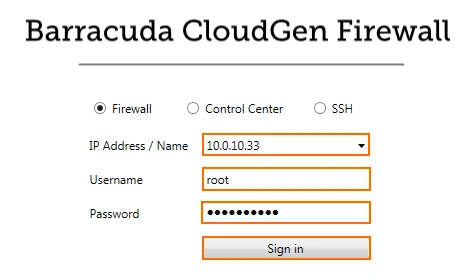
Click Sign In.
Recent Connections
To simplify access, and for informational purposes, Barracuda Firewall Admin automatically stores box names and IP addresses of recently established Firewall Admin sessions in the Recent Sessions list. All connections are listed in the menu bar on the top left of the page.
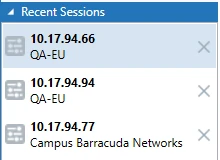
To arrange Firewall Admin sessions in groups, right-click a session in the list and select New Group.
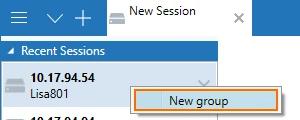
Enter a descriptive name in the header field.
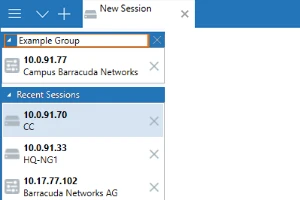
To add a session to the group, drag it into the group list. You can expand and collapse the group view by clicking the arrow icon in the left corner of the header field. To remove a session from the group, click the X icon, or right-click the entry and select Recent Sessions. To remove a group from the list, click the X icon next to the group header field. After a group has been deleted, all sessions are moved back to the Recent Sessions list.
To change a host entry in the Recent Sessions list on a CloudGen Firewall:
Go to CONFIGURATION > Configuration Tree > Box > Network.
In the left menu, expand the Configuration Mode section and click Advanced View.
In the left menu, select IP configuration.
Click Lock.
Change the Hostname.
Click Send Changes and Activate.
Perform a Failsafe network activation. For more information, see How to Activate Network Changes .
To change a host entry on a Control Center:
Go to CONFIGURATION > Configuration Tree > Multi-Range > Global Settings > CC Identity.
In the left menu, select Identification.
Change the Organization.
Click Send Changes and Activate.
If you want to remove a connection from the list, click the X icon next to the entry.
Changing Display Settings
If you do not want IP addresses or other details of recent connections to be visible in the Recent Sessions list, adjust the client settings:
Click the hamburger menu on the top left of the window.
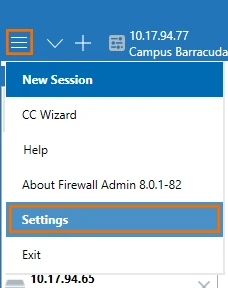
Go to Settings > Client Settings.
In the Log in section, select or clear the following checkboxes:
Save session information – Enables/disables information to be displayed in the Recent Sessions list.
Save user name – Enables/disables user details to be displayed.
User Interface
The Firewall Admin user interface is divided into several functional sections. Although the content on a CloudGen Firewall differs from the Firewall Control Center, position and basic functions are identical. The following screenshot shows the Firewall Admin application connected to a Control Center:
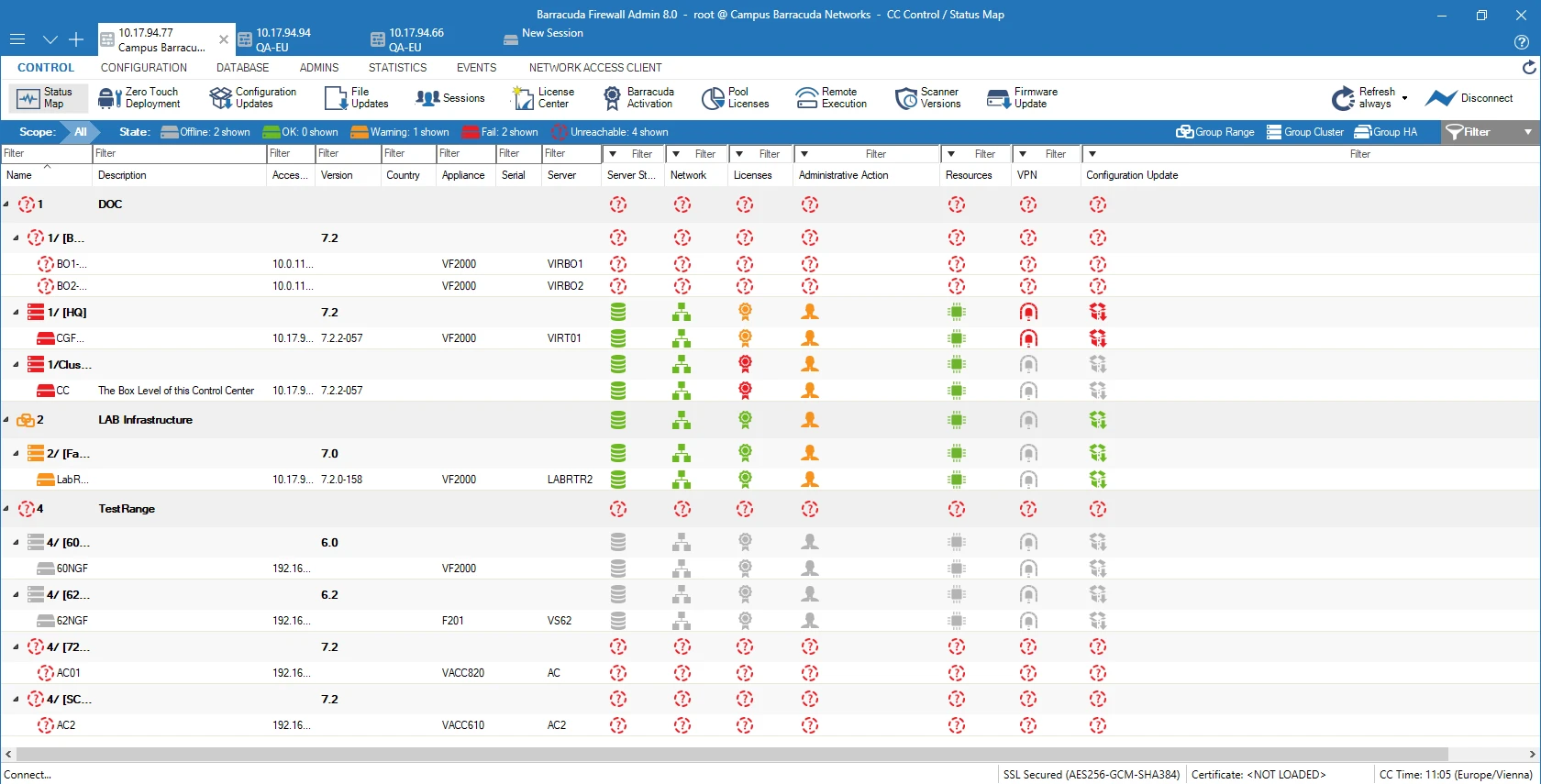
Box Tabs
A tab above the ribbon bar is created for each CloudGen Firewall or Control Center you are logged into. You can log into a single system multiple times. You can also reorganize the tabs by dragging them.

The tab for the selected unit is always highlighted. Clicking open tabs allows you to switch between connected units.
Click the hamburger menu on the top left to access the Firewall Admin settings menu, where you can configure general settings for the Firewall Admin application, such as the behavior of connections and configuration elements.

For more information, see Barracuda Firewall Admin Settings.
Service Bar
The service bar is the main navigation and operation utility of the user interface and provides a tab for each main section of the CloudGen Firewall or Control Center. Additional services introduced on the Firewall Firewall CloudGen, like VPN, add further tabs to this bar from where you can access settings and sub-sections, depending on the configured service.

On the CloudGen Firewall, the Firewall Admin interface service bar contains the following tabs:
DASHBOARD – Provides a general system overview of your CloudGen Firewall or Firewall Control Center (box level). For more information, see DASHBOARD Tab.
CONFIGURATION – Contains the operative configuration tree for the CloudGen Firewall or Control Center. For more information, see CONFIGURATION Tab.
CONTROL – Shows information about services, current network status, running processes, system and license status. For more information, see CONTROL Tab.
FIREWALL – Provides real-time and historical information on network traffic and application traffic passing the CloudGen Firewall. For more information, see FIREWALL Tab.
DHCP – Shows DHCP leases and reservations. For more information, see DHCP Tab.
NETWORK ACCESS CLIENT – Shows information from all connected NAC clients and the Access Control Service. For more information, see Barracuda Network Access and VPN Client.
VPN – Provides access to VPN real-time information for site-to-site and client-to-site VPN connections, if configured. For more information, see VPN Tab.
PROXY – For more information, see PROXY Tab.
LOGS – Contains information related to system and service logs. For more information, see LOGS Tab
STATISTICS – Contains information related to statistics generated on the Barracuda CloudGen Firewall. For more information, see STATISTICS Tab.
EVENTS – Contains information related to events that are created on the Barracuda CloudGen Firewall. For more information, see EVENTS Tab.
SSH – Provides the login to the command line interface of the CloudGen Firewall. For more information, see SSH Tab and Command-Line Interface.
Right-click the Refresh icon on the top right to access the context menu with the following options:
Refresh service tabs – Reloads the Firewall Admin interface.
Reconnect session to unit – Reconnects the Firewall Admin session.
Enter new Password and reconnect session to unit – Reconnects the Firewall Admin session using a login password.

On the Firewall Control Center, the Firewall Admin interface service bar contains the following tabs:
CONTROL – Provides an overview of all connected units on the Firewall Control Center. For more information, see CC CONTROL Tab.
CONFIGURATION – Contains the configuration sections for the Firewall Control Center. For more information, see CC CONFIGURATION Tab.
DATABASE – Provides details and quick access to available ranges, clusters, boxes, and services of the Firewall Control Center. For more information, see CC DATABASE Tab.
ADMINS – Provides access to the section for the administrator's list. For more information, see CC ADMINS Tab.
STATISTICS, EVENTS – These tabs contain pages related to logs, statistics, and events.
NETWORK ACCESS CLIENT – Shows information from all connected NAC clients and the Access Control Service. For more information, see Barracuda Network Access and VPN Client.
FWAUDIT – Provides access to the section for the Firewall Audit service. For more information, see CC FWAUDIT Tab.
Ribbon Bar
Located directly under the service bar, the ribbon bar provides icons for each section relevant to the selected service bar tab. To access a section, open a tab in the service bar and select an icon from the ribbon bar to open the corresponding settings page. In some cases, you might have to expand the icons section in the ribbon bar to gain access to all sections.

In the top-right corner, the ribbon bar provides icons to specify system refresh settings. Clicking the last icon disconnects the unit. When disconnected, this icon changes to Connect.
Main Window
The main window contains the configuration and information part of Firewall Admin. Depending on the tabs and icons selected from the service and ribbon bars, the main window displays information that is relevant to the selected item and might also contain further tabs and subsections.
Context Menu
For entries and items displayed on a page, Barracuda Firewall Admin provides a corresponding context menu. The options that are available when right-clicking an entry depend on the entry. The following settings are standard and included on nearly all of the pages:
Show grouped – Groups the list entries according to the number of transports.
Show Filter – Groups the list entries according to the number of transports.
Find – Groups the list entries according to the number of transports.
Select All – Selects and highlights all entries on the list.
Deselect All – Deselects all entries on the list.
Expand /Collapse All – Expands / collapses all entries on the list.
Print List – Sends the list to a printer.
Columns – Opens a context menu that allows customization of the list view.
Status Bar
The status bar at the bottom of the Firewall Admin user interface displays information about the certificate status, the TLS connection, and the time zone specified within the box time settings.

Barracuda CloudGen Firewall Configuration
On the CONFIGURATION page, you can configure all settings and services of the CloudGen Firewall or Firewall Control Center. The config tree contains all configuration sections, listed in hierarchical levels, from where you can add and access firewall services, and, if on a Firewall Control Center, create and configure ranges and clusters, and add your CloudGen Firewalls. For more information, see CONFIGURATION Tab.
Switching from the Web Interface to Firewall Admin
Hardware firewalls using the web interface as the default management interface can use Firewall Admin in monitor mode with a read-only configuration. Alternatively, you can also disable the web interface and use Firewall Admin to manage the firewall configuration.
For more information, see How to Use Barracuda Firewall Admin in Monitor Mode and How to Switch from the Web Interface to Barracuda Firewall Admin.
